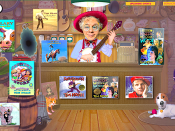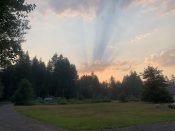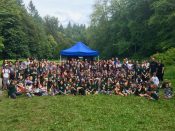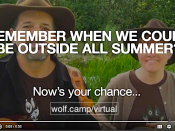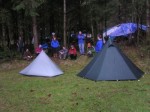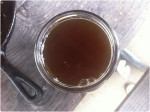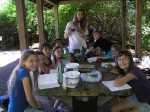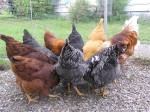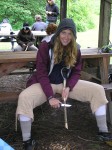Wolf Journey Journal Cover Page for Field Exercise # 005
Name of Field Exercise: Chapter One Celebration
Dates & Times of Study Site Visits:
1600-1800, September 3, 2010
1800-2000, September 12, 2010
Plants, Animals, Minerals Experienced: (make up a name / give it a number if unsure)
I’m not sure whether it’s the season, whether my senses are keener at the end of a summer camp season living outdoors, or if I am simply more familiar with my study site now, but there has been so much action lately! I couldn’t help but to mention much of the action in the title to this post, as you can see. First, I’ll mention the species that I got photos of:
Where Seen, Status and/or Health, if known:
Yellow Jackets: Besides the above photographed species, we’ve been dealing with a nest of yellow jackets just above the doorway. They don’t bother me at all, as I simply capture any annoying ones under a cup on the table and then release them when I leave the area. I’ve never seen anyone get stung by these critters, but I suppose it happens.
Mammals In & Under House: Skunks have visited a couple of nights this past week, and it’s interesting to me that they only show up once in a blue moon. The raccoons have lived in the trees all summer; however, every time it rains at night, the coons go back under the house, and we know right away because Skye-dog gets agitated and starts sniffing the floors. I was also a bit smug wondering why rodents haven’t left any sign of their presence in this old house while no one was living here, but two pair of rats moved in during the summer when our compost was ripest; a Barn Owl even left one as a gift in the yard, so we took its cue and trapped the ones in the house. Fortunately, they hadn’t yet reproduced, and we’ll do an autopsy soon to determine health.
Mammals in the Field: Coyotes have started to bed down in the now-dry field just off the NW corner of the garage. In fact, they have been howling almost every night. One night, I heard them near the garage, but was busy so asked Kim to go and see exactly where they were. She went to the edge of the garage, and was close enough to hear one of them sniff! They also got into my meat-waste-hole, but it was my fault because I buried it there before noticing their lays – about 5 feet away just over the split-rail fence!
Birds Migrating: Finally, Kim pointed out some neo-tropical migrants passing through the feeder area, including a warbling vireo. The Swainson’s thrushes have stopped calling in Clark’s Creek Park, but I wasn’t there enough to guess when they migrated away. Being busy this time of year makes it even harder to notice the silent departures of birds:(
Description and/or Drawing/Photo of Individual, Track or Sign: Today it was actually my goal to finish Field Exercise 005 – Chapter One Celebration, which included the experience of “wandering”, reflections on Ishi, and drawing a new study site map. Wandering around my site was wonderful after a busy summer season, and it grounded me into my focus for the academic year, which is to re-develop Wolf Journey classes and curricula. Here we go! Also, I didn’t re-read Ishi, and his story is controversial due to departmental politics at UC Berkely, so I’m not sure how to present that when I re-write Chapter One. However, I did re-draw my study site map:
Approx Temperature when you were at study site, plus today’s high and low, if known: Lows have been in the upper 40s and highs have been in the upper 60s. Perfect weather, with a couple days of rain. People have been complaining about the summer being cool, but I think it was perfect. Living outside, and visiting my study site so often, I think I have a slightly better perspective than the average bear. I bet outdoor workers, roads maintenance people, etc. would agree with my assessment of the summer. It was different than ever before, though, so we’ll see if that was a harbinger of climate change.
Wind direction and strength when you were at study site, plus other wind factors today if known: Well, the Puyallup Fair started last Friday, so you can really tell which way the wind is blowing depending on the smell and sounds. If it’s coming from the east, like on Friday, then it smells like candy-corn and sounds like people are in the throwes of death with screams from the scary rides. If the wind is from the west, like today, then it sounds like town noise and a slight whiff of marine air.
Describe any precipitation and cloud cover while at study site and at other times today if known: I dug a couple holes around my study site last week to see where the water table is during our annual dry season. For 10 months of the year, it’s pretty much on the surface. What I found while digging holes amazed me. The water table was 4 feet down, and the ground layers largely consisted of 1 foot of soil built up from when this was range land, 6 inches of natural soil from when this was an old growth rainforest, 1 foot of clay-laden soil from when this was a bunch of decaying wetlands, followed by seeminly endless river sand from when this was the Puyallup River. If I kept going, I would probably find a thick layer of Lahar cement from the last time Mt. Rainier really blew up. It’s only a matter of time before all these cycles repeat!
Approx. Humidity while at study site, plus any changes you noticed: 50% average.
Barometric Pressure, if known: 30.12 in, falling
Ground water level, lake/stream/river level, or tides: 3.0 foot under surface since it rained
Degrees above the southern horizon the sun was at noon (1 p.m. DST), or where it rose or set on the horizon as viewed from your secret place: 46.8 degrees above southern horizon at 12:05. Hoping I remember to watch the sunset and mark where it goes down tomorrow, and sunrise as well!
Phase of the moon, and where it rose or set on the horizon as viewed from your secret place, or degrees above the southern horizon at midnight (or 1 a.m. DST): Waxing 20% Crescent; Rose at 11:35, Sets at 20:20. It’s amazing how low in the southern sky it is when it sets as the sun seems to move south, and how high in the sky it will be when full in the winter. Amazing how perspective changes!
Describe and/or draw in any extra space above the arrangement of the planets you saw in the sky (and if possible, what constellations were overhead, rising or setting) and at what time of night: It’s been interesting living in town lately, as teh nighttime skies have been less apparent, but I’ve been watching Mars and Jupiter and Venus all year, but haven’t in the last couple of weeks. I’ll have to get on that!
Were you prepared for this field exercise? Did you start and complete it at good times? Did you accomplish what you set out to do? Yes, and I’m loving it!
Write if and/or how you are progressing toward the goals you wrote before this chapter. What were your best achievements and greatest challenges today out in the field, while studying, or while working on a Wolf Journey project. Name at least one achievement. Getting a map done that doesn’t look like I’m in kindergarten!
How are your physical health, emotional feelings and mental attitude today? It may be best to put any further feelings about yourself or others in your diary, unless it has to do with a large turning point in your life as an earth skills specialist. I’ve been working out since the end of the summer camp season, so I’m feeling pretty good.
Further observations, field experiences, uses and research of species/minerals studies: Psyched that I’ve gotten to learn more about soils as well as insects since Kim has been studying permaculture lately and she’s also so great with the little critters!
Further comments on your your goals, achievements, or planned research if you need to do additional work or study site time before completing this field exercise: Time to write my goals for the Fall:
1. Do a field exercise every two weeks during the fall in order to learn more as well as set an example for those wanting to complete Wolf Journey using this online blog system.
2. Develop Wolf Journey Classes so that by November they are running as we would like.
3. Look forward to winter when I can re-write Wolf Journey Parts 1-3 as well as Part Six – Trail of the Environmental Educator in time for that book to be in use for staff next summer!
Additional drawings, photos, etc:

